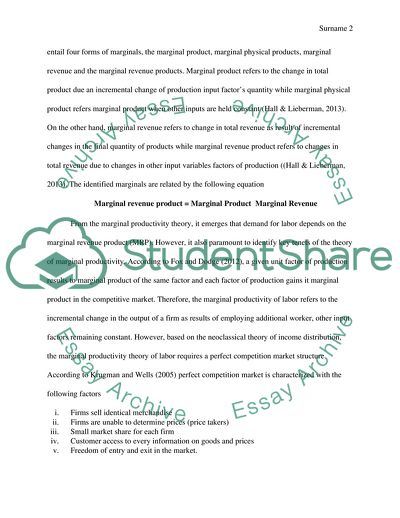Cite this document
(Outline the marginal productivity theory of labour demand and explain Essay, n.d.)
Outline the marginal productivity theory of labour demand and explain Essay. https://studentshare.org/macro-microeconomics/1846773-outline-the-marginal-productivity-theory-of-labour-demand-and-explain-how-the-model-can-be-adopted-to-explain-the-demand-for-labour-of-a-perfectly-competitive-firm-in-the-short-run-and-in-the-long-run-discuss-the-implications-your-analysis-has-for-the-el
Outline the marginal productivity theory of labour demand and explain Essay. https://studentshare.org/macro-microeconomics/1846773-outline-the-marginal-productivity-theory-of-labour-demand-and-explain-how-the-model-can-be-adopted-to-explain-the-demand-for-labour-of-a-perfectly-competitive-firm-in-the-short-run-and-in-the-long-run-discuss-the-implications-your-analysis-has-for-the-el
(Outline the Marginal Productivity Theory of Labour Demand and Explain Essay)
Outline the Marginal Productivity Theory of Labour Demand and Explain Essay. https://studentshare.org/macro-microeconomics/1846773-outline-the-marginal-productivity-theory-of-labour-demand-and-explain-how-the-model-can-be-adopted-to-explain-the-demand-for-labour-of-a-perfectly-competitive-firm-in-the-short-run-and-in-the-long-run-discuss-the-implications-your-analysis-has-for-the-el.
Outline the Marginal Productivity Theory of Labour Demand and Explain Essay. https://studentshare.org/macro-microeconomics/1846773-outline-the-marginal-productivity-theory-of-labour-demand-and-explain-how-the-model-can-be-adopted-to-explain-the-demand-for-labour-of-a-perfectly-competitive-firm-in-the-short-run-and-in-the-long-run-discuss-the-implications-your-analysis-has-for-the-el.
“Outline the Marginal Productivity Theory of Labour Demand and Explain Essay”. https://studentshare.org/macro-microeconomics/1846773-outline-the-marginal-productivity-theory-of-labour-demand-and-explain-how-the-model-can-be-adopted-to-explain-the-demand-for-labour-of-a-perfectly-competitive-firm-in-the-short-run-and-in-the-long-run-discuss-the-implications-your-analysis-has-for-the-el.


